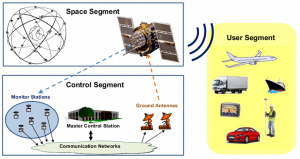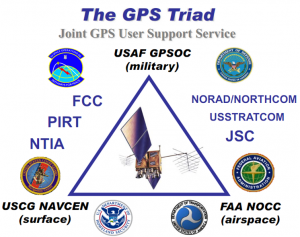If you wish to contribute or participate in the discussions about articles you are invited to contact the Editor
GPS Architecture
| GPS | |
|---|---|
| Title | GPS Architecture |
| Edited by | GMV |
| Level | Basic |
| Year of Publication | 2011 |
The GPS architecture is divided into three major segments: a GPS Space Segment (SS), a GPS Ground Segment (CS), and a GPS User Segment (US).
The Space Segment
The main functions of the GPS Space Segment are to transmit radio-navigation signals with a specific signal structure, and to store and retransmit the navigation message sent by the Control Segment. These transmissions are controlled by highly stable atomic clocks on board the satellites.
The United States is committed to maintaining the availability of at least 24 operational GPS satellites, 95% of the time. To ensure this commitment, the Air Force has been flying 31 operational GPS satellites for the past few years.[1]
The Ground Segment
The GPS Ground Segment (also referred to as Control Segment) is the responsible for the proper operation of the GPS system.
The Ground Segment is comprised of four major subsystems: [2]
- Master Control Station (MCS)
- Alternate Master Control Station
- Network of ground antennas (GAs),
- Network of globally-distributed monitor stations (MSs).
The Master Control Station (MCS) processes the measurements received by the Monitor Stations (MS) to estimate satellite orbits (ephemerides) and clock errors, among other parameters, and to generate the navigation message. These corrections and the navigation message are uploaded to the satellites through the Ground Antennas, which are co-located in four of the Monitor stations (Ascension Island, Cape Canaveral, Diego Garcia, and Kwajalein).
The User Segment
The GPS User Segment is composed by GPS Receivers. Their main function is to receive GPS signals, determine pseudoranges (and other observables), and solve the navigation equations in order to obtain their coordinates and provide a very accurate time. Please refer to GNSS Receivers.
Boundaries Among Segments
The communication boundaries between these three segments are documented in the Interface Control Documents (ICDs):[3]
- IS-GPS-200:[4] defines the requirements related to the interface between the GPS space and user segments of the GPS for radio frequency (RF) link 1 (L1) and link 2 (L2).
- IS-GPS-705):[5] defines the requirements related to the interface between the GPS space and user segments of the GPS for radio frequency (RF) link 5 (L5).
- IS-GPS-800:[6] Defines the characteristics of the L1 Civil (L1C) signal transmitted from GPS satellites to navigation receivers on radio frequency link 1 (L1).
- IS-GPS-240::[7] Defines the functional data transfer interface between the GPS Control Segment (CS) and the GPS user and user-support communities during the Operational Control System (OCS) / Architecture Evolution Plan (AEP) system era.
- ICD-GPS-870:[8] This ICD defines the functional data transfer interface between the GPS Next Operational Control System (OCX) and the GPS user and user-support communities; captures the same interface as ICD-GPS-240, but for the OCX era.
Besides these interface documents, the following three centers (privately referred as the Big Three or the GPS triad) provide a interface between GPS and any user, civilian or military:[9]
- U.S. Strategic Command GPS Operations Center (GPSOC): is the Department of Defense (DoD) primary point of contact for information regarding status of GPS Precise Positioning Service (PPS) and GPS Standard Positioning Service (SPS). The GPSOC is in charge of responding to inquiries and providing information regarding the GPS constellation and the existence of space segment anomalies or issues that could result in GPS outages worldwide.
- U.S. Coast Guard (USCG) Navigation Center (NAVCEN): is the primary interface to all civil non-aviation users of GPS. It provides capabilities for question or issue resolution regarding GPS anomalies and interference reporting, to support maritime and land users with prioritized approach for safety-of-life applications.
- Federal Aviation Administration (FAA) National Operations Control Center (NOCC): Responsible for the management and resolution of all aviation reported interference. Due to the safety-of-life considerations, the FAA has well-defined procedures for dealing with the notification and coordination of any interference reports from aviation users, which includes the processing of National Airspace System (NAS) interference reports and specifically, GPS interference reports.
Notes
References
- ^ GPS Space Segment information in GPS official website
- ^ GPS Ground Segment in GPS official website
- ^ GPS Interface Control Documents ICDs
- ^ Interface Specification IS-GPS-200, Revision L
- ^ Interface Specification IS-GPS-705, Revision G
- ^ Interface Specification IS-GPS-800, Revision G
- ^ Interface Specification IS-GPS-240, Revision C
- ^ Interface Specification ICD-GPS-870, Revision E
- ^ U. S. Positioning, Navigation, and Timing Interference Detection and Mitigation Plan Summary


